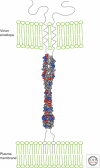HIV Restriction Factors and Mechanisms of Evasion
- PMID: 22553496
- PMCID: PMC3331687
- DOI: 10.1101/cshperspect.a006940
HIV Restriction Factors and Mechanisms of Evasion
Abstract
Retroviruses have long been a fertile model for discovering host-pathogen interactions and their associated biological principles and processes. These advances have not only informed fundamental concepts of viral replication and pathogenesis but have also provided novel insights into host cell biology. This is illustrated by the recent descriptions of host-encoded restriction factors that can serve as effective inhibitors of retroviral replication. Here, we review our understanding of the three restriction factors that have been widely shown to be potent inhibitors of HIV-1: namely, APOBEC3G, TRIM5α, and tetherin. In each case, we discuss how these unrelated proteins were identified, the mechanisms by which they inhibit replication, the means used by HIV-1 to evade their action, and their potential contributions to viral pathogenesis as well as inter- and intraspecies transmission.
Figures





References
-
- Bergeron JR, Huthoff H, Veselkov DA, Beavil RL, Simpson PJ, Matthews SJ, Malim MH, Sanderson MR 2010. The SOCS-box of HIV-1 Vif interacts with ElonginBC by induced-folding to recruit its Cul5-containing ubiquitin ligase complex. PLoS Pathog 6: e1000925 10.1371/journal.ppat.1000925 - DOI - PMC - PubMed
-
- Best S, Le Tissier P, Towers G, Stoye JP 1996. Positional cloning of the mouse retrovirus restriction gene Fv1. Nature 382: 826–829 - PubMed
Publication types
MeSH terms
Substances
Grants and funding
LinkOut - more resources
Full Text Sources
Other Literature Sources
Medical
